
Flexible business processes using jBPM5
- 2. Flexible business processes using jBPM5 Kris Verlaenen jBPM5 Lead Engineer
- 4. Monitoring
- 7. Increased agility A business process is a process that describes the order in which a series of steps need to be executed, using a flow chart.
- 8. BPM Approaches System / EAI Oriented Human Centric Model Oriented Decision Centric Event Driven Content Driven Social Case Management
- 10. targeting developers and business users
- 11. collaboration, management and monitoring using web-based consoles
- 12. powerful rules and event integration
- 13. From Workflow to BPM BPMN 2.0 XML Persistence Trans- actions Events Integration Core Engine
- 15. Unstructured, non-lineair or flexible processes
- 18. What is flexibility? “ The quality of being adaptable or variable”
- 19. What is business process flexibility? “ The ability to implement change or variability in a business process, due to environmental changes”
- 20. Flexibility = Variability + Change
- 22. By deviation
- 24. By change [2008] Towards a Taxonomy of Process Flexibility M.H. Schonenberg, R.S. Mans, N.C. Russell, N.A. Mulyar and W.M.P. van der Aalst
- 27. Revolutionary
- 31. Ad hoc [2006] Taxonomy of flexibility in business processes Gil Regev, Pnina Soffer, Rainer Schmidt
- 37. Processes + Rules + Events
- 38. Vision jBPM as the process engine in a knowledge-oriented platform for developers and business users
- 39. ? Business Problem Semantics Processes Events Rules Processes Rules Events Semantics
- 42. Tooling (IDE, repository, management)
- 43. Model Deploy Execute Monitor Analyze Life Cycle Mining Analysis Optimization Simulation Testing Design Monitoring Reporting Execution Integration Deployment Management Audit Human Interaction Collaboration
- 46. Higher-level
- 47. Loosely-coupled
- 49. Process Rules : Data-driven constraints
- 50. Triggers : Rules / events start / signal process
- 51. Assignment rules
- 52. Describing exceptional situations using rules
- 53. Modularizing concerns using rules
- 54. Using rules to dynamically alter the behavior of the process Rules and Process Integration
- 55. Exceptional Control Flow 90% 5% 3% 2%
- 56. Exceptional Control Flow 90% Rule1 When ... Then ... Rule2 When ... Then ... Rule3 When ... Then ... 5% 3% 2%
- 57. Example: Build Management Hudson Execution and Scheduling Architecture
- 58. Example: Build Management Hudson Execution and Scheduling Architecture
- 59. Continuum Data-driven Lifetime Stability Granularity Change Dynamic Complexity Declarative User-focused
- 60. Processes + Rules + Events
- 66. [email_address]
- 67. jBPM user forum
- 68. Flexible business processes using jBPM5 Kris Verlaenen jBPM5 Lead Engineer
Editor's Notes
- We step up a level and show the rules engine being used within the insurance application process. In this case, the process task for calculating price calls the rules engine, presenting the facts about the applicant, and received the price to pass along to the next steps in the business process (in this case responding to the customer).
